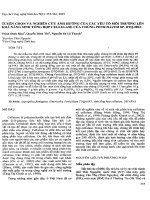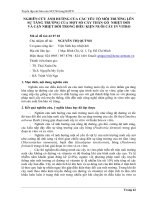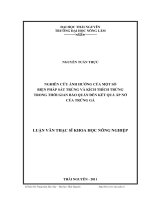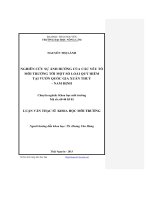Nghiên cứu ảnh hưởng của sự lo lắng đến việc nghe hiểu của học sinh lớp 12 trường trung học phổ thông Gia Viễn A.
Bạn đang xem bản rút gọn của tài liệu. Xem và tải ngay bản đầy đủ của tài liệu tại đây (337 KB, 17 trang )
VIET NAM NATIONAL UNIVERSITY, HA NOI
UNIVERSITY OF LANGUAGES & INTERNATIONAL STUDIES
FACULTY OF POST – GRADUATE STUDIES
*****************
LƯƠNG THỊ THÚY HẰNG
A SURVEY RESEARCH ON THE INFLUENCES LEFT BY ANXIETY ON
LISTENING COMPREHENSION OF GRADE 12th STUDENTS AT GIA VIEN A
HIGH SCHOOL.
Nghiên cứu ảnh hưởng của sự lo lắng đến việc nghe hiểu của học sinh lớp 12
trường Trung học Phổ thông Gia Viễn A.
M.A. Minor Programme Thesis
Field: English Teaching Methodology
Code: 60140111
Hà Nội- 2016
VIET NAM NATIONAL UNIVERSITY, HA NOI
UNIVERSITY OF LANGUAGES & INTERNATIONAL STUDIES
FACULTY OF POST – GRADUATE STUDIES
*****************
LƯƠNG THỊ THÚY HẰNG
A SURVEY RESEARCH ON THE INFLUENCES LEFT BY ANXIETY ON
LISTENING COMPREHENSION OF GRADE 12th STUDENTS AT GIA VIEN A
HIGH SCHOOL.
Nghiên cứu ảnh hưởng của sự lo lắng đến việc nghe hiểu của học sinh lớp 12
trường Trung học Phổ thông Gia Viễn A.
M.A. Minor Programme Thesis
Field: English Teaching Methodology
Code: 60140111
Supervisor: Assoc. Prof. Dr. Phan Văn Quế
Hà Nội- 2016
TABLE OF CONTENTS
DECLARATION ..................................... ERROR! BOOKMARK NOT DEFINED.
ACKNOWLEDGMENTS ...................... ERROR! BOOKMARK NOT DEFINED.
ABSTRACT ............................................. ERROR! BOOKMARK NOT DEFINED.
TABLE OF CONTENTS .......................................................................................... I
LIST OF ABBRIVIATIONS .................. ERROR! BOOKMARK NOT DEFINED.
LIST OF TABLES AND FIGURES. ..... ERROR! BOOKMARK NOT DEFINED.
PART I. INTRODUCTION .................................................................................. III
1. RATIONALE FOR THE RESEARCH ............................................................................III
2. AIMS AND OBJECTIVES OF THE RESEARCH .............................................................. V
3. THE RESEARCH QUESTIONS ..................................................................................... V
4. SCOPE OF THE STUDY .............................................................................................. V
5. METHOD OF THE STUDY ........................................................................................ VI
6. SIGNIFICANCE OF THE STUDY ............................................................................... VI
7. DESIGN OF THE STUDY ......................................................................................... VII
PART II. DEVELOPMENT .............................................................................. VIII
CHAPTER 1. LITERATURE REVIEW ................................................................... VIII
1. Definition of listening comprehension. ........................................................... VIII
2. Significance of listening................................................................................... VIII
3. Process of listening comprehension ................................................................... IX
4. Anxiety ................................................................................................................. IX
5. Foreign Language Anxiety ................................................................................... X
6. Anxiety in listening comprehension ........................ Error! Bookmark not defined.
CHAPTER 2. METHODOLOGY .........................ERROR! BOOKMARK NOT DEFINED.
1. Restatement of research questions ........................ Error! Bookmark not defined.
2. The fitness of the research approach ..................... Error! Bookmark not defined.
3. Context of the study ................................................ Error! Bookmark not defined.
3.1. Setting of the study ............................................... Error! Bookmark not defined.
3.2. Listening skills in the textbook ........................... Error! Bookmark not defined.
3.3. Participants ........................................................... Error! Bookmark not defined.
4. Research instruments.............................................. Error! Bookmark not defined.
5. Data collection and analysis procedure ................. Error! Bookmark not defined.
6. Summary .................................................................. Error! Bookmark not defined.
CHAPTER 3. DATA ANALYSIS AND FINDINGS. ....... ERROR! BOOKMARK NOT
DEFINED.
3.1. Students’ attitudes towards listening lessons and listening skill.Error! Bookmark not de
3.2. The students’ anxiety when learning listening. . Error! Bookmark not defined.
3.3. Reduction of the listening anxiety....................... Error! Bookmark not defined.
3.4. Concluding remarks............................................. Error! Bookmark not defined.
PART III: CONCLUSIONS................... ERROR! BOOKMARK NOT DEFINED.
1.
SUMMARY OF THE STUDY ......................ERROR! BOOKMARK NOT DEFINED.
2. PEDAGOGICAL IMPLICATIONS ......................ERROR! BOOKMARK NOT DEFINED.
2.1. Select material of general interest level.............. Error! Bookmark not defined.
2.2. Use teachers’ prior knowledge of the material to guide the listeners.Error! Bookmark n
2.5. Use more teaching aids to support for listening lessons.Error! Bookmark not defined.
2.6. Be sympathetic and sensitive to student anxiety about LC and FL
learning. ........................................................................ Error! Bookmark not defined.
3. LIMITATIONS OF THE STUDY AND SUGGESTIONS FOR FURTHER RESEARCH.
............................................................................ERROR! BOOKMARK NOT DEFINED.
REFERENCES ....................................................................................................... XI
APPENDICES ......................................... ERROR! BOOKMARK NOT DEFINED.
PART I. INTRODUCTION
1. Rationale for the research
English is the most popular language in the world. It plays an important role
in our social- economic life of human beings. Indeed, it is no longer an issue. They
argued that English has become a world knowledge by the virtues of the political
and economic progress made by English speaking nations in the past 200 years. It is
now the main of language books, newspapers, airports, international business and
academic
conferences,
science
technology,
medicine,
diplomacy,
sports,
international competitions, music and advertising. Nowadays we live in the age of
globalization so we need English language because it is the language of this age.
The number of foreign language learners is increasing, and foreign language
educators and researchers have been putting efforts into teaching English more
effectively. Along with the desire to find more effective ways of teaching English,
concern over dealing with learners’ negative feelings and attitudes while learning
English has also increased. This concern over learners’ negative feelings and
attitudes is based on a few language learning theories proposed by a number of
language researchers( i.e., Krashen, 1988; Onwuegbuzie, Bailey, & Daley, 1999;
Young, 1991). A number of factors influence foreign language learning, and anxiety
when learning a foreign language has been identified as one critical factor
interfering with foreign language learning and achievements( Horwitz, Horwitz &
Cope, 1991). Among the many skills required to use a language( i.e., speaking,
listening, reading, and writing), listening comprehension is at the heart of language
learning. Language learners are expected to understand what the interlocutor is
saying in order to continue the conversation. When learners have difficulty with
listening comprehension, it is likely that their listening anxiety will increase, which
in turn will negatively affect their performance.
Being exposed to a natural context and an authentic environment is claimed
to be desirable for foreign language learning. Hadley( 2001) asserted that learning
and practicing language in meaningful contexts is more appealing; however, this
way of practicing a foreign language is not always affordable or feasible. Some
foreign language learners may experience higher language anxiety when talking
with native speakers face-to-face, and some may not have an opportunity for
exposure to an authentic environment. Many students may have experienced some
degree of helplessness and anxiety when doing the listening comprehension. In
traditional listening classes, students are given listening materials but not taught
“how” to listen. Most of them do not have appropriate listening strategies. Ever
since language teaching and learning have shifted from the teacher-centered model
to the learner-centered model. A number of studies have been undertaken from the
students’ perspective. Foreign language anxiety is one of the best predictors in
accounting for individual differences in language learning success in second
language acquisition( SLA), and that it is proved to be one of the most essential and
influential affective factors.
At my upper secondary school, learning listening is a really challenging job;
especially, in grade 12 because of students’ low levels of proficiency in term of
vocabulary, grammar, pronunciation, skills and so forth. And they are the reasons
that cause the anxiety when listening of students. The anxiety makes students find it
difficult and tough to listen to and they are not confident enough to do listening
tasks successfully.
The study is based on the assumption that unless teachers understand
students’ anxiety, their teaching of listening comprehension will never be efficient
and effective.
Although it is important to understand students’ anxiety so as to provide
them with needed support, not a single study on the upper secondary school
students’ perceptions of the anxiety they have faced with in comprehending the
listening tasks in the textbook. Being a teacher of English, I myself think that it is
essential to do a research on students’ listening anxiety so I decided on choosing
the topic “A survey research on the influences left by anxiety on listening
comprehension of grade 12th students at Gia Vien A High school.”
2. Aims and objectives of the research
The main purpose of the study is to investigate the anxiety of 12th grade
students towards learning listening skill. It also proposes some suggestions to
minimize the influences on students when learning listening skill.
With the above aims, the objectives of this study were as follows:
•
Examining the effect of anxiety on students in listening lessons.
•
Investigating
the
degree
of
these
influences
on
students’
listening
comprehension.
•
Proposing some suggestions to minimize the negative effect on students when
learning listening skill.
3. The research questions
With the given aims and objectives, the study implies two research questions:
-
Does the anxiety have any influences on listening comprehension of grade
12th students at Gia Vien A high school?
-
What are the effects and sources of foreign language listening anxiety as well
as suggested ways to reduce listening anxiety?
4. Scope of the study
The survey research was conducted at Gia Vien A High school, Ninh Binh
province. Because of limited time, it only focused on investigating the influences of
anxiety on listening comprehension of grade 12th students, the sources and the
degree of the impact.
The participants were 69 students from four classes 12B1, 12B3, 12B6 and
12B9( answer the questions in questionnaire), 10 students( answer the questions in
interview) from classes 12B2, 12B4, 12B7, who are non- English major students.
5. Method of the study
The study was carried out by some steps as follows:
First, the survey questionnaire for students was employed to find out the sources
and effect of anxiety when learning listening skill.
Second, class observation was designed to study students’ performance in listening
lessons.
After that, semi- structured interview was conducted in order to:
1. Survey students’ perception on the magnitude of learning English and
listening skill in students’ learning English.
2. Study the factors that cause their anxiety.
3. Find out the influences left by anxiety in their listening comprehension and
their way of going on the lessons.
Then, the data were collected, sorted and analyzed quantitatively and qualitatively
to obtain realistic results.
To end with, pedagogical implications for minimizing students’ anxiety in learning
listening skill will be proposed based on the results found from all data collection
instruments.
6. Significance of the study
The study has been conducted with the expectation that the findings will help
students of English at Gia Vien A High school acknowledge the significance of the
impact of anxiety when learning listening comprehension, which forces them to
reduce the anxious emotion before listening, spend more time and effort preparing
the listening lessons.
Still, the researcher harbors the hope that the teachers will understand their
students’ anxiety, study the reasons for such anxiety, from which they will know
how to foster positive attitudes or motivation and eliminate the anxious emotion of
their students so as to help them obtain progress and fruitful achievements in
learning English and English listening comprehension.
7. Design of the study
The study consists of three main parts:
Part I: Introduction presents the rationale of the study, the aims, the research
questions, the significance, the scope, the method and the design of the study.
Part II: Development includes three chapters:
Chapter 1: Literature Review, which reviews the theories on listening and English
learning anxiety in listening comprehension.
Chapter 2: Methodology, describes the participants, the setting of the study
involving the school, textbook. Moreover, this chapter shows how the researcher
applied the data collection instruments and her procedure of conducting the study.
Chapter 3: Data analysis and findings, in which the researcher uses both
qualitatively and quantitatively method to study and analyze the Figure and
collected information.
Part III: Conclusions, which summarizes all findings explored and brings out
useful suggestions for the students to reduce their anxiety in learning listening skill.
An overall picture of what has been done in this study and suggestions for further
studies are also included in this part.
PART II. DEVELOPMENT
Chapter 1. LITERATURE REVIEW
1. Definition of listening comprehension.
Listening comprehension is a process, a very complex process, and if we
want to measure it, we must first understand how that process works. An
understanding of what we are trying to measure is the starting point for test
construction. The thing we are trying to measure is called a construct, and our test
will be useful abd valid only if it measures the right construct( Gary Buck, 2001).
And listening comprehension encompasses the multiple processes involved in
understanding and making sense of spoken language. These include recognizing
speech sounds, understanding the meaning of individual words, and/or
understanding the syntax of sentences in which they are presented. Listening
comprehension can also involve the prosody with which utterances are spoken(
which can, e.g., change intended meaning from a statement to a question), and
making relevant inferences based on context, real-world knowledge, and speakerspecific attributes (e.g., to what information the speaker has access and about what
he/she is likely to be talking). For longer stretches of language or discourse,
listening comprehension also involves significant memory demands to keep track of
causal relationships expressed within the discourse( Fred R.volkmar, 2013).
Moreover, listening comprehension refers to the understanding of the implications
and explicit meanings of words and sentences of spoken language.” (
CDE Guidelines for Identifying Students with Specific Learning Disabilities, 2008).
2. Significance of listening
Listening is the first language mode that human beings acquire. It provides
the firm basis for all aspects of language and instinctive reflex development, and it
plays a very important role in the processes of communication. A journal by Tiffany
P. Hogan, Suzanne M. Adlof & Crystle N. Alonzo( 2014), listening comprehension
has a huge effort on reading comrehension starting even in the elementary grades. It
also highlights a growing number of children who fail to develop adequate reading
comprehension skills, primarily due to deficient listening comprehension skills .
Bulletin( 1952, cited in Naizhao Guo, 2005, p.3) said, listening is the fundamental
language skill. It is the medium through which people gain a large portion of their
education, their information, their understanding of the world and of human affairs,
their ideals, sense of values, and their appreciation. In this day of mass
communication, much of it oral, it is of vital importance that students are taught to
listen effectively and critically. According to second language acquisition theory,
language input is the most essential condition of language acquisition. As an input
skill, listening plays a crucial role in students’ language development.
3. Process of listening comprehension
Rost( 2002, cited in Masanori Tokeshi, 2003, p.27) said, the most common
two-levels view is bottom-up processing and top-down processing. In bottom-up
processing listeners first attend to individual phonological units, and decode a larger
unit of input in hierarchical order, from vocabulary to structures, and arrive at the
meaning of the discourse. In top-down processing, listeners make inferences on the
basis of background information, contextual information and expectation. Listening
comprehension is considered to be an interactive process of bottom-up processing
and top-down processing by utilizing linguistic and non- linguistic information(
Rost, 1994, p.32; Nunan, 1999, p.221; Buck, 2001, p.1, cited in Masanori Tokeshi,
2003, p.27).
4. Anxiety
Anxiety is an emotion characterized by an unpleasant state of inner turmoil,
often accompanied by nervous behavior, such as pacing back and forth, somatic
complaints, and rumination( Seligman, M.E.P.; Walker, E.F.; Rosenhan, D.L.).
According to Arlington( 2013, p.189), anxiety is a feeling of fear, uneasiness, and
worry, usually generalized and unfocused as an overreaction to a situation that is
only subjectively seen as menacing. The anxiety also can be “a mental block that
prevents acquirers from fully utilizing the comprehensible input they receive for
language acquisition”( Krashen, 1985, p.3, cited in Fang Xu, 2011, p.1709). This
block, called “the affective filter”, might be because “the acquirer is unmotivated,
lacking in self-confidence, or anxious”( Krashen, 1985, p.3, cited in Fang Xu, 2011,
p.1709). Anxiety always makes us nervous and affects on our performance in many
aspects of life of human beings. The feelings of anxiety and nervousness are
intimately connected to the cognitive side of anxiety, which is worry. Eysenck(
1979, cited in Fang Xu, 2011, p.1709) says that worry wastes energy that should be
used for memory and processing on a type of thinking which in no way facilitates
the task at hand. Classroom anxiety became extreme for the student with the lowest
proficiency. It is helpful for teachers to understand the pressures felt by learners in
the classrooms. Foss and Reitzel( cited in Fang Xu, 2011, p.1710) suggested that
knowledge and skills can best be dealt with through role play, drama, and oral
interpretation.
5. Foreign Language Anxiety
As the number of English learners is constantly increasing, English education
is concerned more and more. As MacIntyre, P. D.; Gardner, R. C.( 1994, cited in
Shabnam Amini Naghadeh, Mansour Amini Naghadeh, Naser Amini Naghadeh,
Hasan Aminpour, 2013, p.85), foreign language anxiety is the feeling
of unease, worry, nervousness and apprehension experienced
when
learning
or
using a second or foreign language. As Fotos( 1998, cited in Shabnam Amini
Naghadeh, Mansour Amini Naghadeh, Naser Amini Naghadeh, Hasan Aminpour,
2013, p.85), these feelings may stem from any second language context whether
associated with the productive skills of speaking and writing, or the receptive skills
of reading and listening. However, unlike English as a second language( ESL)
instruction, EFL instruction in East Asian countries has focused on reading and
writing for the last few decades). He says that nowadays, EFL curricula also
emphasize the importance of oral and listening skills in English. Because of the
REFERENCES
1. Argaman, O., & Abu-Rabia, S. (2002). The influence of language anxiety on
English reading and writing tasks among native Hebrew speakers. Language,
Culture and Curriculum, 15(2), 143-160.
2. Arlington.
(2013). Diagnostic
and
Statistical
Manual
of
Mental
Disorders (Fifth ed.). American Psychiatric Association. VA: American
Psychiatric Publishing, 189.
3. Bailey, P., Onwuegbuzie, A. J. & Daley, C. E. (1999). Foreign language
anxiety and learning style. Foreign Language Annals, 32(1), 63-76.
4. Chastain. (1975). Affective and ability factors in second language
acquisition. Language Learning, 25(1), 53-161.
5. Cheng, Y. S., Horwitz, E. K. & Schallert, D. L. (1999). Language Anxiety:
Differentiating Writing and Speaking Components. Language Learning, 49,
417-446.
6. Crerand, M. E. (1993). From first language literacy to second language
proficiency to second language literacy: The act of writing in a foreign
language context. Paper presented at the AERA Convention, Atlanta, GA.
7. Ehrman M. and R. Oxford. (1995). Cognition plus: Correlates of adult
language proficiency. Modern Language Journal, 79, 67-89.
8. Elkhafaifi, H. (2005). Listening comprehension and anxiety in the Arabic
language classroom. The Modern Language Journal, 89(2), 206-220.
9. Eysenck,
M.
W.
(1979).
Anxiety,
learning
and
memory:
A
reconceptualization. Journal of Research in Personality, 13, 363-385.
10. Fang Xu (2011). Anxiety in EFL Listening Comprehension. Theory and
Practice in Language Studies, 1(12), 1709-1717.
11. Flowerdew, John; Miller, Lindsay. (2005). Second Language Listening:
Theory and Practice, 4.
12. Foss, K., & Reitzel, A. C. (1988). A relational model for managing second
language anxiety. TESOL Quarterly, 22(3), 437-454.
13. Fotos, S. (1998). Shifting the focus from forms to form in the EFL
classroom. ELT Journal, 52(4), 301-307.
14. Fred R.Volkmar. Encyclopedia of Autism Spectrum Disorders, 1743.
15. Gardner, R. C. and P. D. MacIntyre. (1993). on the measurement of affective
variables in second language learning. Language Learning, 43, 157-194.
16. Gardner, R. C., Lalonde, R. N., Moorcroft, R., & Evers, F. T. (1987). Second
language attrition: The role of motivation and use, Journal of Language and
Social Psychology, 6, 29- 47.
17. Gary Buck. (2001). Assessing listening. Cambridge, UK: Cambridge
University Press.
18. Goh, C. C. M. (2002). Exploring listening comprehension tactics and their
interaction patterns. System, 30(2), 185-206.
19. Gordon, Ronald D.( 1985). Empathy: the state of the art and science. Paper
presented at the International Conference of the World Communication
Association.
20. Gregersen, T., & Horwitz, E. (2002). Language learning and perfectionism:
Anxious and non-anxious language learner’s reactions to their own oral
performance. The Modern Language Journal, 86(4), 562-570.
21. Hadley, A. O. (2001). Teaching Language in Context (3rd ed.). Boston, MA:
Heine & Heinle.
22. Hogan TP1, Adlof SM, Alonzo CN (2014). On the importance of listening
comprehension. International Journal of Speech-language Pathology June
16(3), 199- 207
23. Howatt, A. and J. Dakin.( 1974). Language laboratory materials, ed. J. P. B.
Allen, S. P. B. Allen, and S. P. Corder.
24. Horwitz, E. K. (1986). Preliminary evidence for the reliability and validity of
a foreign language anxiety scale. TESOL Quarterly, 20, 559-562.
25. Horwitz, E. K., Horwitz, M. B. & Cope, J. (1986). Foreign language
classroom anxiety. The Modern Language Journal, 70(2), 125-132.
26. Horwitz, E. K., Horwitz, M. B., & Cope, J. A. (1991). Foreign language
classroom anxiety. In E. K. Horwitz and D. J. Young, Language anxiety:
From theory and research to classroom implications( 27-36). Englewood
Cliffs, NJ: Prentice- Hall Inc.
27. Kim, J.-H. (2000). Foreign language listening anxiety: A study of Korean
students learning English. Unpublished doctoral dissertation, University of
Texas, Austin.
28. Kleinmann, H. (1977). Avoidance behaviour in adult second language
acquisition. Language Learning, 27(1), 93-107.
29. Krashen, S. D. (1982). Principles and Practice in Second Language
Acquisition. Oxford, UK: Pergamon Press.
30. Krashen, S. (1988). Second language acquisition and second language
learning. Englewood Cliffs, NJ: Prentice Hall.
31. Larry Vandergrift. (2016). Listening: Theory and practice in modern foreign
language competence. Center for languages linguistics and area studies.
32. MacIntyre, P. D. (1995). How does anxiety affect second language learning?
A reply to Sparks and Ganschow. The Modern Language Journal, 79 (1), 9099.
33. Martin, Robert.(1987). Oral communication. English Language Arts
Concept. Portland, Oregon: State Department of Education.
34. Masanori.(2003). Listening comprehension processes and strategies of
Japanese junior high school students in interactive settings. University of
Wollongong thesis collections.
35. Mejias, H., Applbaum, R. L., Applbaum, S. J., & Trotter, II, R. T.(1991).
Oral communication apprehension and Hispanics: An exploration of oral
communication apprehension among Mexican American students in Texas.
In E. K. Horwitz and D. J. Young, Language anxiety: From theory and
research to classroom implications (87-98). Englewood Cliffs, NJ: PrenticeHall.
36. Naizhao Guo.(2005). An investigation of factors influencing English
comprehension and possible measures for improvement. Paper presented at
the AARE annual conference parramatta.
37. Phillips, Elaine. (1992). The Effects of Language Anxiety on Students‟ Oral
Test Performance and Attitudes. The Modern Language Journal, 76 (1), 1426
38. Saito, Y., Horwitz, E. K. & Garza, T. J. (1999). Foreign language reading
anxiety. The Modern Language Journal, 83(2), 202-218.
39. Scarcella, Robin C., and Rebecca L. Oxford. (1992). The Tapestry of
Language Learning: The Individual in the Communicative Classroom.
Boston: Heinle & Heinle.
40. Scovel, T. (1978). The effect of affect on foreign language learning: A
review of the anxiety research. Language Learning, 28, 129-142.
41. Sellers, V. (2000). Anxiety and reading comprehension in Spanish as a
foreign language. Foreign Language Annals, 33(5), 512-521.
42. Shabnam Amini Naghadeh, Mansour Amini Naghadeh, Naser Amini
Naghadeh, Hasan Aminpour (2013). The relationship between anxiety and
Iranian EFL learners’ listening comprehension. International Journal of
Applied linguistic Studies, 2(4), 84- 90.
43. Shengli Wang (2010). An Experimental Study of Chinese English Major
Students’ Listening Anxiety of Classroom Learning Activity at the
University Level. Journal of Language Teaching and Research,1(5), 562568.
44. Strother, Deborah Burnett.( 1987). Practical applications of research: on
listening. Phi Delta Kappan, 68 (8), 625-628.
45. Seligman, M.E.P; Walker, E.F; Rosenhan, D.L. Abnormal Psychology(4th
ed). New York: W.W. Norton & Company.
46. Young, Dolly Jesuita. (1990). “An Investigation of Students‟ Perspective on
Anxiety and Speaking.” Foreign Language Annals, 23(6), 539-553.
47. Young, D. J. (1991). Creating a low anxiety classroom environment: What
does language anxiety research suggest?. The Modern Language Journal,
75(4), 426-437.
48.
Zhou,
Dandan.
(2003).
Listening
anxiety and affective strategies the in second language classroom.
Foreign Language Teaching Abroad, 3, 56-58.









